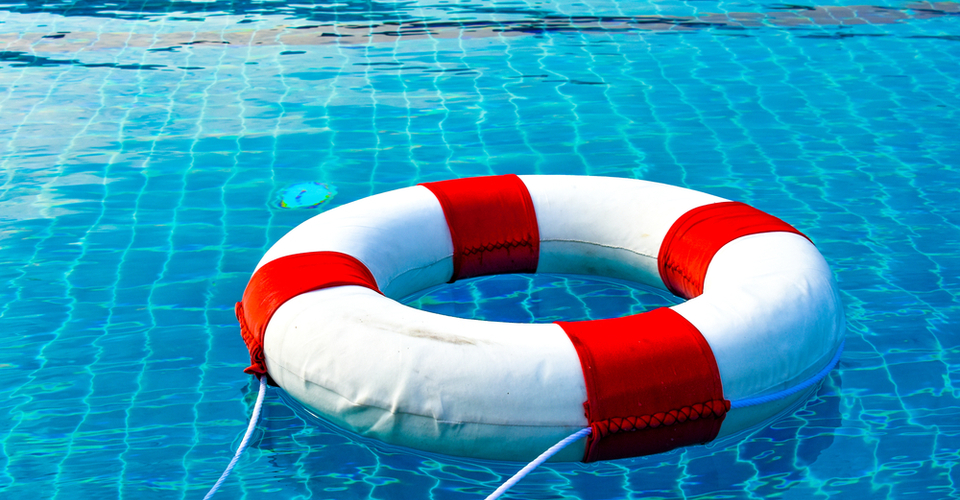As the summer continues to heat up, many families will turn to water activities to stay cool. Whether you’re enjoying a backyard pool or a day at the lake or beach, water can quickly become dangerous. Especially for young children.
According to the Centers for Disease Control and Prevention (CDC), about 10 people die from drowning every day in the U.S. And of those incidents, 20% are children aged 14 or younger.
Additionally, the CDC states that for every child who dies from drowning, another five children receive emergency room care for nonfatal submersion injuries.
Water Safety Tips
 Most people assume that drowning will look and sound like a scene from a movie. But a child drowning is usually a silent process, with no splashing or calls for help.
Most people assume that drowning will look and sound like a scene from a movie. But a child drowning is usually a silent process, with no splashing or calls for help.
This means prevention is key to reducing the chances of water-related injuries and drowning incidents.
Here’s what you can do to stay safe in and around the water.
-
Never leave a child unattended in or near water. Appoint a designated watcher to monitor children during social gatherings. Floatation devices should never be used as a substitute for supervision.
-
Teach children water safety and swimming skills as early as possible. Formal swimming lessons reduce the risk of drowning among children aged 1-4 years old.
-
Have appropriate safety equipment around your pool. Install barriers (e.g. four-sided pool fence), covers and alarms on and around your pool.
-
Remove pool toys from the area. Clear the area of any items that may tempt children into entering the pool area unsupervised.
-
Learn how to perform CPR on infants, children and adults. Every second counts during an emergency. Bystander CPR saves lives and can improve outcomes in drowning victims.
Keep in mind that children can drown in as little as an inch of water. Which means bathtubs, toilets and other sources of water can also quickly become life-threatening situations.
Practice closing the toilet lid and bathroom doors after use to prevent toddlers from falling head-first into water. Be sure to remove standing water from tubs and buckets after you’re done using them. And store outdoor containers upside down, so they don’t collect water.
CPR for infants and children
Everyone should learn CPR, but it’s especially important for parents and caregivers to learn these lifesaving skills.
If you recognize someone is in trouble or is found unresponsive in the water, rescue and remove the person from the water without putting yourself in danger. Ask someone to call 911 and grab an on-site AED.
To perform CPR on an infant (younger than 1 year old), position the child on a firm, flat surface and follow these steps:
-
Place 2 fingers in the center of the chest just below the nipple line.
-
Compress the chest 30 times. Aim for a compression depth of about 1.5 inches.
-
Tilt the head back slightly and lift the chin to open the airway to a neutral position. Don’t tilt the head too far back as this can over-extend the infant’s undeveloped airway and, in turn, block it.
-
Cover the mouth and nose or apply a face mask.
-
Give 2 small breaths for 1 second each. Only attempt 2 breaths, even if the chest doesn’t rise.
-
Immediately resume compressions. And continue cycles of 30 compressions and 2 breaths.
When performing CPR on a child (age 1 to puberty), you’ll follow the same compression and breath cycle. But with some variation in hand placement and airway positioning.
-
Place one or two hands (depending on the size of the child) in the center of the chest between the nipples.
-
Compress the chest hard and fast 30 times. Aim for a depth of about 2 inches.
-
Tilt the head back and lift the chin to open the airway.
-
Pinch the nose or apply a face mask.
-
Give 2 rescue breaths for 1 second each.
-
Immediately resume compressions. And continue cycles of 30 compressions and 2 breaths.
We recommend that everyone take a CPR, AED and First Aid class to practice these skills and get certified in other lifesaving skills. Find an HSI class near you.







.png?width=600&name=HSI-CTA-EmergencyCareTraining%20(1).png)











Comments